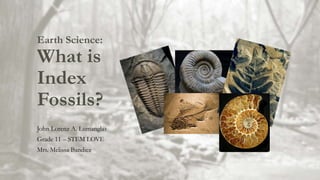
Earth science ppt
- 1. Earth Science: What is Index Fossils? John Lorenz A. Lumanglas Grade 11 – STEM LOVE Mrs. Melissa Bandiez
- 2. Fossil o A fossil is any preserved remains, impression, or trace of any once-living thing from a past geological age. What is Fossil? • Fossils are the remains or traces of ancient life that have been preserved by natural processes, from spectacular skeletons to tiny sea shells. Imprints, tracks and trails can also become fossilised, like dinosaur footprints or worm burrows. These are called trace fossils.
- 3. Clues from fossils • Fossils are our best form of evidence about the history of life on earth. • Fossils can give us clues about past climates, the motions of plates, and other major geological events. • The first clue that fossils can give is whether an environment was marine (underwater) or terrestrial (on land). • Along with the rock characteristic, fossils can indicate whether the water was shallow or deep, and whether the rate of sedimentation was slow or rapid.
- 4. How are Index Fossils Formed? • Index fossils form in the same way other fossils form. The most common method is permineralization. • Index fossils are used to define geological periods. These fossils can be defined as "commonly found, widely distributed fossils that are limited in time span." If one finds an index fossil in a given layer, then one has bounds on the age of the layer. Using index fossils, the geological periods are defined.
- 5. How are Index Fossils Formed? • Index fossils are the preserved remains of specific species found in the strata of sedimentary rock. They are easily recognized by shape and lived for either a short period of time, geologically speaking, or completely vanished from the Earth in a known extinction event. Index fossils are usually sea creatures due to preservation conditions and how widespread ocean-dwelling creatures can proliferate on the planet.
- 6. Types of Fossils • Fossilization can occur in many ways. Most fossils are preserved in one of five processes; preserved remains, permineralization, molds and casts, replacement, and compression.
- 7. Preserved Remains • The rarest form of fossilization is the preservation of original skeletal material and even soft tissue. For example, insects have been preserved perfectly in amber, which is ancient tree sap. Several mammoths and even a Neanderthal hunter have been discovered frozen in glaciers.
- 8. Permineralization • The most common method of fossilization is permineralization. After a bone, wood fragment, or shell is buried in sediment, it may be exposed to mineral-rich water that moves through the sediment. This water will deposit minerals, typically silica, into empty spaces, producing a fossil.
- 9. Molds and Casts • In some cases, the original bone or shell dissolves away, leaving behind an empty space in the shape of the shell or bone. This depression is called a mold. Later, the space may be filled with other sediments to form a matching cast in the shape of the original organism.
- 10. Replacement • In some cases, the original shell or bone dissolves away and is replaced by a different mineral. For example, shells that were originally calcite may be replaced by dolomite, quartz, or pyrite
- 11. Compression • Some fossils form when their remains are compressed by high pressure. This can leave behind a dark imprint of the fossil. Compression is most common for fossils of leaves and ferns, but can occur with other organisms, as well.
- 12. Exceptional Preservation • Some rock beds have produced exceptional fossils. Fossils from these beds may show evidence of soft body parts that are not normally preserved. Two of the most famous examples of soft organism preservation are the Burgess Shale in Canada and the Solnhofen Limestone in Germany.
- 13. Index Fossils and Living Fossil • Index fossil, any animal or plant preserved in the rock record of the Earth that is characteristic of a particular span of geologic time or environment. A living fossil is an extant taxon that cosmetically resembles ancestral species known only from the fossil record.
- 14. Using Index Fossils to Correlate Rock Layer • We can use index fossils and key beds to correlate, or match rock layers that are the same age. By doing this we can then place other layers of rocks in order of their relative ages to find the oldest and youngest rocks in a series of outcrops.
- 15. That’s all, Thank You!